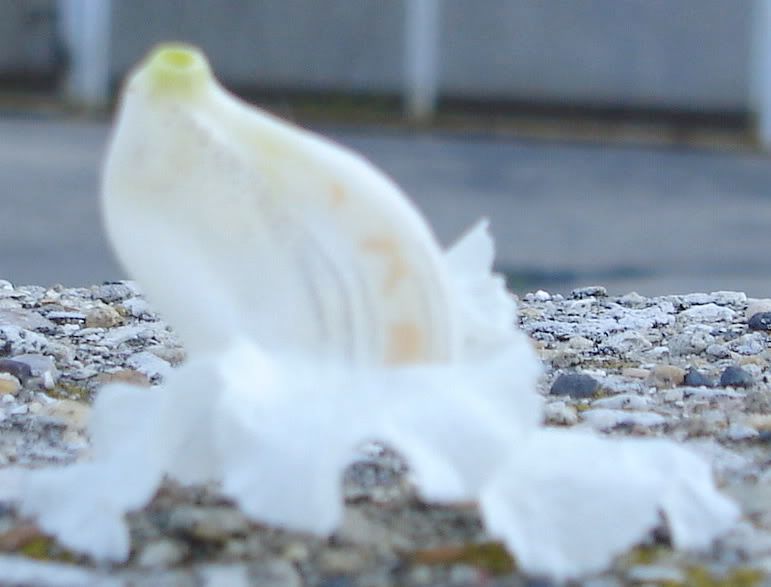When I was in Evansville, IN last month, I did a lot of walking. I would walk from my mother’s house on Madison Avenue just East of Highway 41 to the library downtown.
These walks took me straight down Washington Avenue to Haynie’s Corner, where Washington goes left to S.E. 2nd Street and right to Parrett and Third Street. This was not entirely unintentional. Besides being the most direct way to the new Central Library** it took me past the corner of Third and Parrett Streets.

Third & Parrett Streets, Evansville, Indiana. Where did the marker go?
The intersection is one of those strange cut-in intersections that is a result of the original Evansville plat being SE-NW and growing due East and North.
I was looking for something specific. When I was in high school I brought my Grandma into town for lunch one day and we went walking. She brought me to this weird little intersection to show me something. A plaque. I wanted to get a picture of it.
But there was nothing to be found. I asked around and a few people say they remember it. I know it was there when I moved to Chicago in 2000. Now I am pissed.
The plaque commemorated a Civil War refugee camp that used to be there. It doesn’t seem like much to some folks, maybe. To me it is part of my core.
I put away thinking about it when I came back to the city until I stumbled across this thread on Metafilter a couple of days later. I made a comment, but my mind was cloudy and I wasn’t thinking as clearly as I could have been. I NEEDED to respond, though, so I did. Now I feel like I need to flesh it out a bit.
The Metafilter thread was a link to The Civil War Isn’t Tragic, an article by Ta-Nehisi Coates. Ta-Nehisi writes for the Atlantic and has written some of the best modern social and racial commentary in his time there.
I have the same reaction to the Civil War that he does. It does not mean as much for me and where I am today as it does for him (I am white and he is black) but we are in agreement.
It drives me nuts when I hear or read about Southern Romanticism, Civil War battle reenactments, or how maybe slaves had decent masters and it wasn’t all that bad… It drives me absolutely bananas when I am in Southern Indiana and see a Confederate flag as a bumper sticker or flying from a truck or in a window.
The Civil War wasn’t tragic. It was the first step in what should have been the real leveling of American society. It was a bloody birth that gave us the opportunity to make things right. And we squandered it.
Let’s start at the beginning…
This is my Aunt Sarah Elliott:

Sarah Elliott*** c. 1880
Sarah was born in the late 1840s in Elliott, IN. Her parents were Welsh-Irish immigrants who were farmers, devout Methodists, and proud American abolitionists. She grew up with the idea that one man shouldn’t own another. It was part of their interpretation of the American identity that everyone really IS equal. One of the family sayings was (and still is): “If you are good enough to work for me, then you are good enough to eat at my table”. When there were too many workers to eat in the dining room properly, tables would be set up on the farm and everyone ate al fresco. We are in the United States!
Her brother, William Elliott, was quick to volunteer for Union service when the war broke out. He served in the 42nd Indiana Volunteer Infantry from October of 1861 until October of 1864.

William's tombstone at Bluegrass cemetery in Elliott, IN
She then spent time with family in Evansville during the conflict at that refugee camp helping people get settled and reinvent their lives while her brother fought. He was taken prisoner at Perryville, KY at one point and was discharged in October of 1864 in Rome, Georgia.
The cedar trees in our front yard on our property where I grew up were trees that he brought back in his suitcase from the battle of Lookout Mountain.

Cedar, Juniperus Virginiana, from battle of Lookout Mountain in Elliott, IN.
After the war, the family tried to do what they could to help reconstruction along. Sarah and her mother took in orphans that were wandering the countryside and sent them to school so that they wouldn’t be taken advantage of by farmers who were using the refugees as cheap (often horribly abused and mistreated) labor. They worked in town to help women get work and Sarah taught freed slaves that were now in Indiana to read.
All of this is to say that I grew up being PROUD of what these people did. I grew up hearing about how OUR PEOPLE (meaning my family, not white people generally) did our part for the American struggle for equality. I grew up with my Grandma lamenting that Southerners and Copperheads prevented a proper reconstruction and brought on the racial woes that we as a country had to face for decades after what should have been the beginning of the end of it. I grew up with the idea that April 9, 1865 is when the American dream of real independence truly began.
What does this have to do with anything? A whole damn lot.
Being from original Lincoln Republican stock, it makes me sick that there has been a shift in the way we look at the Civil War and what it meant to the people fighting. You hear about the tragedy of brother-against-brother and you read about how it wasn’t really about slavery but about “State’s Rights” you hear any number of things that may have some grain of truth, but (and let’s use the crazy-people caps lock for this):
I AM HERE TO TELL YOU AS A DESCENDANT OF PEOPLE WHO ENLISTED AND FOUGHT, WHO WORKED TO MAKE THIS NATION AND THIS WORLD A BETTER PLACE… FOR THEM IT HAD EVERYTHING TO DO WITH SLAVERY.
RIGHT FROM THE BEGINNING.
They didn’t care about whether South Carolina printed their own money or Tennessee could give women the vote. They were concerned with their own souls in the eyes of their god and they were willing to fight and shed their own blood so that the taint of slavery would not be on them.
Period.
In fact, they weren’t particularly thrilled with the consolidation of Federal power that the war brought with it, but freedom trumped it all. Freedom trumped everything.
As far as Lincoln changing direction into it and making it about slavery:
“The greatest thing about the President isn’t that he is one of History’s great leaders. The greatest thing is that he admitted to being wrong and did what was right.” That was what my Grandma said about her mother’s take on his stance on slavery and why he is a hero.
So please, the next time you hear some idiot tell you that the Civil War was about State’s Rights and that slavery was secondary at best or perhaps even an accidental point in the whole affair, please remember my Aunt Sarah and her bother William.
Remember what they did and how they thought about it. The problem is that time is slipping by and people like me – people who still have these kinds of stories to tell – are going away without writing them down. Cedars in the front yard become “those trees that have been there forever” and Uncle Will becomes an unmarked black and white photograph fading in a box in the attic. I am lucky because I am so young for someone who has this much of a physical, historical, and emotional connection to it. Eventually we will lose everyone who has a connection. That is how History gets re-written, and it isn’t good.
*Tangentially related: I was having a conversation with a Rabbi friend of mine. We were talking about the origin of the Reform Jewish movement in Germany and America in the 19th century and it struck me that there is something similar in America as it relates to general race relations, how we understand each other… It got me thinking something… something about assimilation… Something about the idea that if people just put aside and tuck away what makes them different culturally things will be OK… If we just try to fit in well enough and blend blend blend everything will be fine… Like a battered woman who, if she just makes the dinner without burning it, will go one more day without being hit…
**Kudos to Evansville on the Library, by the way. It is probably the nicest and most useful thing to have gone up in a long time.
***Her married name was actually Sarah Elliott Smith, but through a particularly gothic turn of events**** we don’t use Smith.
****She was the first wife of her future sister-in-law’s first husband and died of TB around 1888 at 40. Got it? It takes a second and isn’t really easy to grok without more background. You will just have to wait for my genealogy blog to come out.










 contemplative
contemplative



















